kottke.org posts about science
It turns out if you break some kinds of slow-growing corals into tiny pieces, these microfragments grow much much faster than usual, even 25-50 times faster.
“Part of the coral had grown over the back side and had attached to the bottom of the aquarium,” he said. When he grabbed it, “it broke off and left two or three polyps behind. I thought I just killed those. But oh, well, I moved the puck over.”
A week later he happened to glance at the abandoned polyps — the individual hydra-shaped, genetically identical organisms that make up a coral colony — on the bottom of the aquarium. “I noticed that those one to three polyps were now five to seven polyps,” he said. “They not only had lived — they had grown and had doubled in size.”
It was, he said, “my eureka mistake.” He cut a few more polyps from the original colony and placed them on other pucks. “And they grew like crazy. The coral seems to want to repair itself quickly and grow back over its lost ground before something else takes its territory.”
Both this and the article about the quickly regenerating corals I posted last month seem to hinge on a realization scientists have had recently about coral: what matters most is the surface area, not the volume. You look at a massive brain coral and you think the whole thing is the organism, but most of it is just a base for the thin layer of stuff coating it that actually matters.
A new analysis of the genomes of two extinct human species (Neanderthals and Denisovans) shows more clearly that they interbred with our species of human, contributing 2-4% of our modern genomes in some cases.
“What it begins to suggest is that we’re looking at a Lord of the Rings-type world — that there were many hominid populations,” says Mark Thomas, an evolutionary geneticist at University College London who was at the meeting but was not involved in the work.
But, more interestingly, the analysis also detected the Denisovans also bred with an as-yet-unknown species of humans.
The Denisovan genome indicates that the population got around: Reich said at the meeting that as well as interbreeding with the ancestors of Oceanians, they also bred with Neanderthals and the ancestors of modern humans in China and other parts of East Asia. Most surprisingly, Reich said, the genomes indicate that Denisovans interbred with yet another extinct population of archaic humans that lived in Asia more than 30,000 years ago — one that is neither human nor Neanderthal.
Is this the first time a new human species has been discovered through DNA evidence alone?
Google Research built an interactive periodic table of the elements where you can see the relative amounts of the elements as found in the human body, in the sea, and, most interestingly, by the number of mentions in books.

If you’ve ever wondered why the periodic table is shaped the way it is, click on “electrons” under “Shape” and pay attention to the number of electrons in the outer shells in each column of elements. Amazingly, when Dmitri Mendeleev and German chemist Julius Meyer published the first periodic tables in 1869/1870, the elements were organized only by atomic weights and chemical properties; they didn’t know what an electron was and certainly weren’t aware of quantum shells of electrons. (via @djacobs)
Photographer Ernie Button photographs the dried remains of single malt scotch whiskies, which end up looking like desolate landscapes on distant worlds.

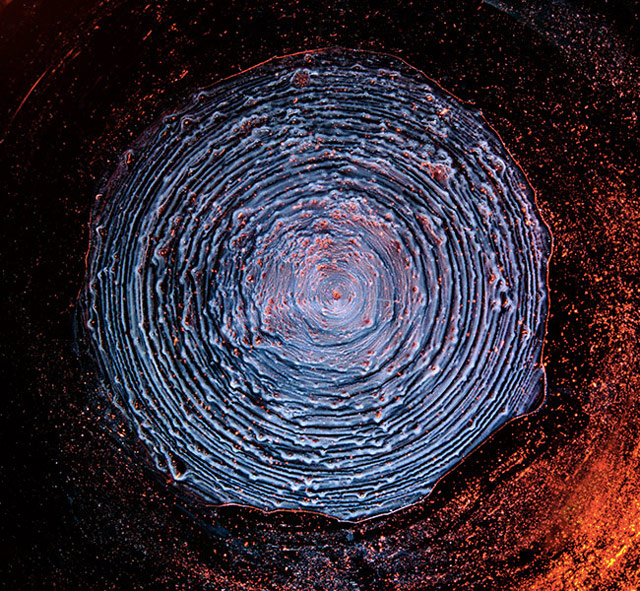
Curious as to how these patterns were formed by some kinds of whiskey but not others, Button reached out to an engineering professor at Princeton.
Dr. Stone’s group found that the key difference in whisky is that unlike coffee, it consists of two liquids — water and ethyl alcohol. The alcohol evaporates more quickly, and as the fraction of water increases, the surface tension of the droplet changes, an effect first noticed in the 19th century by an Italian scientist, Carlo Marangoni. That, in turn, generates complex flows that contribute to the patterns Mr. Button photographed.
“Here, they actually looked at what happens when you change the fluids that are drying,” said Dr. Yunker, who is soon heading to the Georgia Institute of Technology as a physics professor, “and they found some very neat effects.” (That would be neat in the usual sense of “cool and intriguing” and not as in “I’ll have my whisky neat.”)
(via @pomeranian99)
Now this is an ambitious Kickstarter project: Lunar Mission One wants to send an unmanned probe to an unexplored area of the Moon, land on the surface, drill a hole at least 20 meters in depth to analyze geological composition of the Moon, and then drop a time capsule in the hole that will last 1 billion years. That’s. Insane.
We’re going to use pioneering technology to drill down to a depth of at least 20m — 10 times deeper than has ever been drilled before — and potentially as deep as 100m. By doing this, we will access lunar rock dating back up to 4.5 billion years to discover the geological composition of the Moon, the ancient relationship it shares with our planet and the effects of asteroid bombardment. Ultimately, the project will improve scientific understanding of the early solar system, the formation of our planet and the Moon, and the conditions that initiated life on Earth.
The Rosetta mission has opened the way for a new era of pioneering space exploration and demonstrates the public appetite to engage with the secrets of the solar system. We want this to be a truly international mission that everyone everywhere can get involved in, so we are using Kickstarter to finance the next phase of development. This is your chance to be part of Lunar Mission One and to reserve your place in space. Your pledge will reserve you a digital memory box that will be buried in the moon during the mission as part of a 21st Century time capsule.
This is a great way to think about how big the planets of our solar system are: in terms of fruits.
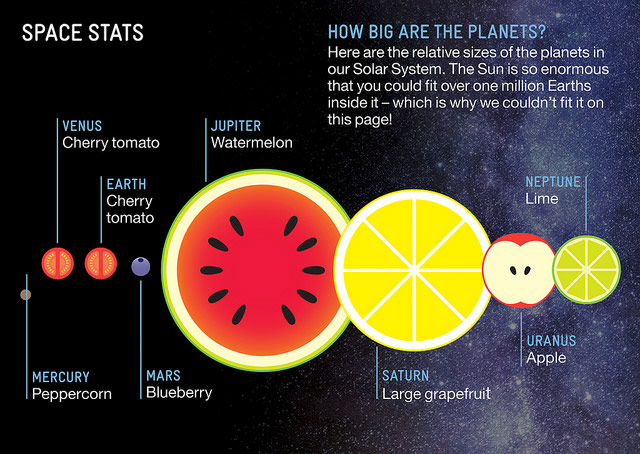
(via boing boing)

A European Space Agency landing craft the size of a washing machine is scheduled to land on a comet tomorrow, November 12, 2014. How cool is that?
Never before has a space mission put a lander on a comet. But the European Space Agency (ESA) plans to change that. Its Rosetta craft has been orbiting comet 67P/Churyumov-Gerasimenko since August and is set to release the washing-machine-sized lander, Philae, on 12 November. This would set in motion a nail-biting seven-hour fall designed to deliver Philae to a landing site called Agilkia on the comet’s surface. Philae is programmed to beam data and images back to Earth to help scientists to understand comets, including whether these conglomerations of ice, rock and dust supplied our planet with water and other building blocks of life when they smashed into it billions of years ago.
You can watch the landing live (or here too)…touch down on the comet’s surface is scheduled for 11:03 AM EST. Here’s a full rundown of the events on landing day. Good luck, Philae!
Update: Randall Munroe of XKCD is live drawing the landing.
Kip Thorne is a theoretical physicist who did some of the first serious work on the possibility of travel through wormholes. Several years ago, he resigned as the Feynman Professor of Theoretical Physics from Caltech in part to make movies. To that end, Thorne acted as Christopher Nolan’s science advisor for Interstellar. As a companion to the movie, Thorne wrote a book called The Science of Interstellar.
Yet in The Science of Interstellar, Kip Thorne, the physicist who assisted Nolan on the scientific aspects of Interstellar, shows us that the movie’s jaw-dropping events and stunning, never-before-attempted visuals are grounded in real science. Thorne shares his experiences working as the science adviser on the film and then moves on to the science itself. In chapters on wormholes, black holes, interstellar travel, and much more, Thorne’s scientific insights — many of them triggered during the actual scripting and shooting of Interstellar — describe the physical laws that govern our universe and the truly astounding phenomena that those laws make possible.
Wired has a piece on how Thorne and Nolan worked together on the film. Phil Plait was unimpressed with some of the science in the movie, although he retracted some of his criticism. If you’re confused by the science or plot, Slate has a FAQ.
Update: Well, well, the internet’s resident Science Movie Curmudgeon Neil deGrasse Tyson actually liked the depiction of science in Interstellar. In particular: “Of the leading characters (all of whom are scientists or engineers) half are women. Just an FYI.” (via @thoughtbrain)
Update: What’s wrong with “What’s Wrong with the Science of Movies About Science?” pieces? Plenty says Matt Singer.
But a movie is not its marketing; regardless of what ‘Interstellar”s marketing said, the film itself makes no such assertions about its scientific accuracy. It doesn’t open with a disclaimer informing viewers that it’s based on true science; in fact, it doesn’t open with any sort of disclaimer at all. Nolan never tells us exactly where or when ‘Interstellar’ is set. It seems like the movie takes place on our Earth in the relatively near future, but that’s just a guess. Maybe ‘Interstellar’ is set a million years after our current civilization ended. Or maybe it’s set in an alternate dimension, where the rules of physics as Phil Plait knows them don’t strictly apply.
Or maybe ‘Interstellar’ really is set on our Earth 50 years in the future, and it doesn’t matter anyway because ‘Interstellar’ is a work of fiction. It’s particularly strange to see people holding ‘Interstellar’ up to a high standard of scientific accuracy because the movie is pretty clearly a work of stylized, speculative sci-fi right from the start.
(via @khoi)
This is a time lapse of the surface of the Sun, constructed of more than 17,000 images taken by the Solar Dynamics Observatory from Oct 14 to Oct 30, 2014. The bright area that starts on the far right is sunspot AR 12192, the largest observed sunspot since 1990.
The sunspot is about 80,000 miles across (as wide as 10 Earths) and it’s visible from Earth with the naked eye. Best viewed as large as possible…I bet this looks amazing on the new retina iMac. (via @pageman)

A children’s book about space featuring information graphics illustrated by the completely awesome Jennifer Daniel!?
The third in a visually stunning series of information graphics that shows just how interesting and humorous scientific information can be. Complex facts about space are reinterpreted as stylish infographics that astonish, amuse, and inform.
INSTANT PURCHASE. February 2015 cannot come fast enough.
In 2013, a group of researchers published a paper called Collective Motion of Moshers at Heavy Metal Concerts. The paper’s abstract reads:
Human collective behavior can vary from calm to panicked depending on social context. Using videos publicly available online, we study the highly energized collective motion of attendees at heavy metal concerts. We find these extreme social gatherings generate similarly extreme behaviors: a disordered gas-like state called a mosh pit and an ordered vortex-like state called a circle pit. Both phenomena are reproduced in flocking simulations demonstrating that human collective behavior is consistent with the predictions of simplified models.
The authors built an interactive mosh pit simulation based on their simplified models. You can try it out right here:
(via @nickrichter)
If you believe in gravity, then you know that if you remove air resistance, a bowling ball and a feather will fall at the same rate. But seeing it actually happen, in the world’s largest vacuum chamber (122 feet high, 100 feet in diameter), is still a bit shocking.
In the late 1500s, Galileo was the first to show that the acceleration due to the Earth’s gravity was independent of mass with his experiment at the Leaning Tower of Pisa, but that pesky air resistance caused some problems. At the end of the Apollo 15 mission, astronaut David Scott dropped a hammer and a feather in the vacuum on the surface of the Moon:
Science!
In a rare bit of good news about climate change, it appears that some types of coral have the ability to recover more quickly from trauma caused by rising ocean temperatures (archive).
At Palau in the western Pacific, a survey completed just three years after the 1998 bleaching event showed more coral had recovered on reefs within protected bays and on deep slopes.
Scientists suggest this is because heat and light serve as a double-whammy to coral health and corals that hang out in shady zones will escape the scorching combination, upping the chances that remnants will survive.
Seven years after the bleaching event, some reefs had regained nearly 40 per cent of their corals, with two species of plate-like acroporid coral, A. digitifera and A. hyacinthus, particularly prevalent. “We sampled plating coral colonies there a few years ago and found them to be pool-table size,” says Stephen Palumbi, Director of Stanford University’s Hopkins Marine Station, in Pacific Grove, California, US.

Today’s Google Doodle honors Jonas Salk on what would have been his 100th birthday. Salk developed the first successful polio vaccine in 1955 and was hailed as a hero for it.
On April 12, 1955, Dr. Thomas Francis, Jr., of the University of Michigan, the monitor of the test results, “declared the vaccine to be safe and effective.” The announcement was made at the University of Michigan, exactly 10 years to the day after the death of President Roosevelt. Five hundred people, including 150 press, radio, and television reporters, filled the room; 16 television and newsreel cameras stood on a long platform at the back; and 54,000 physicians, sitting in movie theaters across the country, watched the broadcast on closed-circuit television. Eli Lilly and Company paid $250,000 to broadcast the event. Americans turned on their radios to hear the details, department stores set up loudspeakers, and judges suspended trials so that everyone in the courtroom could hear. Europeans listened on the Voice of America. Paul Offit writes about the event:
“The presentation was numbing, but the results were clear: the vaccine worked. Inside the auditorium Americans tearfully and joyfully embraced the results. By the time Thomas Francis stepped down from the podium, church bells were ringing across the country, factories were observing moments of silence, synagogues and churches were holding prayer meetings, and parents and teachers were weeping. One shopkeeper painted a sign on his window: Thank you, Dr. Salk. ‘It was as if a war had ended’, one observer recalled.”
Because of Salk’s vaccine and subsequent vaccines, the US has been polio-free since 1979.
Lockheed Martin is in the process of developing a compact fusion reactor they say could revolutionize the world’s energy industry.
Dubbed the compact fusion reactor (CFR), the device is conceptually safer, cleaner and more powerful than much larger, current nuclear systems that rely on fission, the process of splitting atoms to release energy. Crucially, by being “compact,” Lockheed believes its scalable concept will also be small and practical enough for applications ranging from interplanetary spacecraft and commercial ships to city power stations. It may even revive the concept of large, nuclear-powered aircraft that virtually never require refueling-ideas of which were largely abandoned more than 50 years ago because of the dangers and complexities involved with nuclear fission reactors.
The key difference in Lockheed’s approach seems to be the configuration of the magnetic field containing the reaction:
The CFR will avoid these issues by tackling plasma confinement in a radically different way. Instead of constraining the plasma within tubular rings, a series of superconducting coils will generate a new magnetic-field geometry in which the plasma is held within the broader confines of the entire reaction chamber. Superconducting magnets within the coils will generate a magnetic field around the outer border of the chamber. “So for us, instead of a bike tire expanding into air, we have something more like a tube that expands into an ever-stronger wall,” McGuire says. The system is therefore regulated by a self-tuning feedback mechanism, whereby the farther out the plasma goes, the stronger the magnetic field pushes back to contain it. The CFR is expected to have a beta limit ratio of one. “We should be able to go to 100% or beyond,” he adds.
Charles Seife, who wrote a book about the history of fusion, is skeptical of Lockheed’s claims.
This week, Lockheed Martin supposedly managed to achieve a “breakthrough” in nuclear fusion that has gotten a lot of media attention. As Charles Seife points out, it did so “without having built a prototype device that, you know, fuses things on an appreciable scale. It’s a stunning assertion, even by fusion-research standards. But a quick look at the defense contractor’s ambitious plan-a working reactor in five years-already shows the dream fraying around the edges. A year and a half ago, the company promised that fusion was four years away, meaning that the schedule is already slipping. Negative one years of progress in 20 months is, sadly, business as usual for fusion. At this rate, it’ll take Lockheed Martin at least a decade before the natural endpoint: desperately spinning victory out of an underwhelming result generated by a machine whose performance comes nowhere near predictions-and which brings us no closer to actually generating energy from a fusion reaction.”
This is fun…Aatish Bhatia maps out the forces and motions involved in doing an ollie on a skateboard.
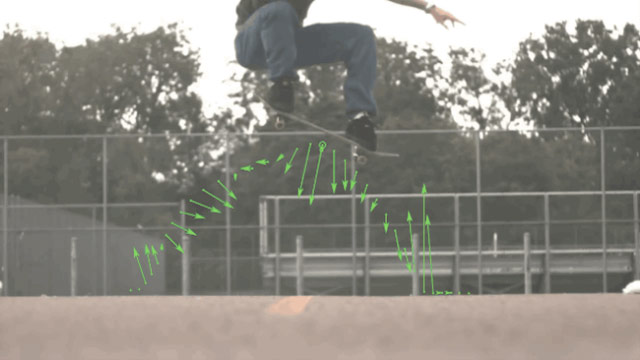
It’s a neat piece of science art, and it also tells us something interesting. The arrows show us that the force on the skateboard is constantly changing, both in magnitude as well as in direction. Now the force of gravity obviously isn’t changing, so the reason that these force arrows are shrinking and growing and tumbling around is that the skater is changing how their feet pushes and pulls against the board. By applying a variable force that changes both in strength and direction, they’re steering the board.
Gorgeous videos of chemical reactions (precipitation, bubbling, crystallization, etc.). I think the metal displacement reaction video is my favorite:
(via hn)

The sound made by the Krakatoa volcanic eruption in 1883 was so loud it ruptured eardrums of people 40 miles away, travelled around the world four times, and was clearly heard 3,000 miles away.
Think, for a moment, just how crazy this is. If you’re in Boston and someone tells you that they heard a sound coming from New York City, you’re probably going to give them a funny look. But Boston is a mere 200 miles from New York. What we’re talking about here is like being in Boston and clearly hearing a noise coming from Dublin, Ireland. Travelling at the speed of sound (766 miles or 1,233 kilometers per hour), it takes a noise about 4 hours to cover that distance. This is the most distant sound that has ever been heard in recorded history.
A much much smaller eruption occurred recently in Papua New Guinea. From the video, you can get a tiny sense of the sonic damage unleashed by Krakatoa:
Holy smoking Toledos indeed. On Reddit, a user details how loud a Saturn V rocket is and what the effects would be at different distances. At very close range, the sound from the Saturn V measures an incredible 220 db, loud enough to melt concrete just from the sound.
At 500 meters, 155 db you would experience painful, violent shaking in your entire body, you would feel compressed, as though deep underwater. Your vision would blur, breathing would be very difficult, your eardrums are obviously a lost cause, even with advanced active noise cancelling protection you could experience permanent damage. This is the sort of sound level aircraft mechanics sometimes experience for short periods of time. Almost twice as “loud” as putting your ear up to the exhaust of a formula 1 car. The air temperature would drop significantly, perhaps 10-25 degrees F, becoming suddenly cold because of the air being so violently stretched and moved.
Even at three miles away, the sound is loud enough to cause permanent hearing damage. But that’s nothing compared to the Krakatoa sound. The Saturn V sound is ~170 db at 100 meters away while the Krakatoa explosion was that loud 100 miles away! What happens at 170 db?
…you would be unable to breathe or likely see at all from the sound pressure, glass would shatter, fog would be generated as the water in the air dropped out of suspension in the pressure waves, your house at this distance would have a roughly 50% chance of being torn apart from sound pressure alone. Military stun grenades reach this volume for a split second… if they are placed up to your face. Survival chance from sound alone, minimal, you would certainly experience permanent deafness but probably also organ damage.
The word “loud” is inadequate to describe how loud that is. (thx, david)
Update: Sperm whales are loud! 200 decibels in water and 174 in air.
But the whale is not really as loud as the rocket, she told me. Because water is denser than air, sound in water is measured on a different decibel scale. In air, the sperm whale would still be extremely loud, but significantly less so - 174 decibels. That’s roughly equivalent to the decibel levels measured at the closest barometer, 100 miles away from the Krakatoa eruption, and is loud enough to rupture people’s ear drums. Suffice to say, you probably don’t want to spend a lot of time swimming with the sperm whales.
Every year, evolutionary biologist and professor David Barash gives his students The Talk about how evolution and religion do and do not get along.
It’s irresponsible to teach biology without evolution, and yet many students worry about reconciling their beliefs with evolutionary science. Just as many Americans don’t grasp the fact that evolution is not merely a “theory,” but the underpinning of all biological science, a substantial minority of my students are troubled to discover that their beliefs conflict with the course material.
Until recently, I had pretty much ignored such discomfort, assuming that it was their problem, not mine. Teaching biology without evolution would be like teaching chemistry without molecules, or physics without mass and energy. But instead of students’ growing more comfortable with the tension between evolution and religion over time, the opposite seems to have happened. Thus, The Talk.
This is the sort of thing Barash talks about:
The more we know of evolution, the more unavoidable is the conclusion that living things, including human beings, are produced by a natural, totally amoral process, with no indication of a benevolent, controlling creator.
(via @TomJunod)
Eleanor Lutz has a degree in molecular biology, works as a designer, and loves to combine the two interests by making these wonderful information graphics on her site, Tabletop Whale. Her most recent post is an animated graphic showing how several animals (birds, bats, insects) move their wings while flying.
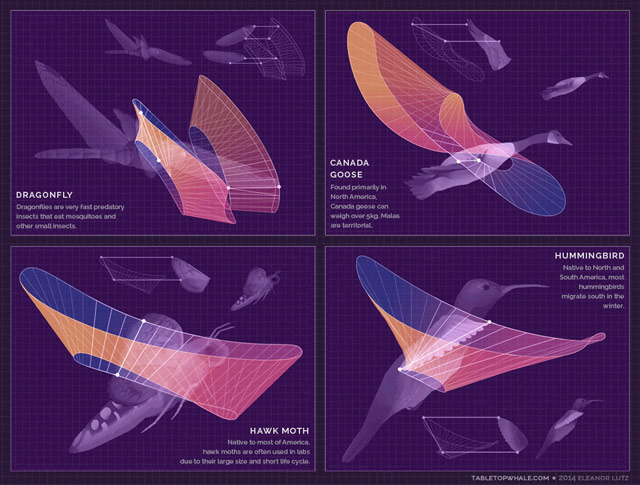
I love love love Lutz’s animated chart of North American butterflies. So playful!

There are only four posts on the site so far, but she’s done other stuff as well; this woodcut map for instance. Prints are available…I’m getting one of the butterflies for sure.
Give me even the simplest gravity simulator and I will play with it for many many minutes. Or hours. Or days. (Send help!)
This looks like a time lapse, but it’s not. It’s just a straight-up gorgeous video of the aurora borealis filmed in Yellowknife, Northwest Territories, Canada.
It is real time motion! NOT time-lapse. Brighter the Aurora, faster the movement.
(via the kid should see this)
Erik Vance on why real working archaeologists don’t care for Indiana Jones.
“Oh God,” he groans, “Don’t even go there. Indiana Jones is not an archeologist.”
It’s not surprising that academics — hell bent on taking the fun out of everything — would hate our beloved and iconic movie version of them. But Canuto is no killjoy. His ironic tone and acerbic wit seem honed by long boring days in the sun. So I bite. I quickly learn that there’s a good reason why most every archeologist on Earth hates Indy. And that they might have a point. Because Jones isn’t an archeologist at all.
“That first scene, where he’s in the temple and he’s replacing that statue with a bag of sand — that’s what looters do,” Canuto says, grinning. “[The temple builders] are using these amazing mechanisms of engineering and all he wants to do is steal the stupid gold statue.”
Makes you wonder if Jones was one of the Raiders referred to in the title of the first movie. (via @riondotnu)
As part of a course he was teaching, a biologist sent away for a genetic testing kit from 23andMe for himself and his parents. When he went looking for other relatives on the service (which is now an automatic opt-out feature), he discovered he had a half-brother his dad had not told his family about.
At first, I was thinking this is the coolest genetics story, my own personal genetics story. I wasn’t particularly upset about it initially, until the rest of the family found out. Their reaction was different. Years of repressed memories and emotions uncorked and resulted in tumultuous times that have torn my nuclear family apart. My parents divorced. No one is talking to my dad. We’re not anywhere close to being healed yet and I don’t know how long it will take to put the pieces back together.
After this discovery was made, I went back to 23andMe and talked to them. I said, “I’m not sure all your customers realize that when they participate in your family finder program, what they’re participating in what are essentially really advanced paternity tests.” People find out that their parents aren’t who they think they are. They have nearly a million people in the database. If there happens to be anyone in there you’re related to, they’ll find your match. This is a solid science.
I know a family in which one of the children is adopted and they haven’t told her. Which is crazy…she’s gonna find out eventually (through something like 23andMe or because of some medical emergency or test) and go totally berzerk.
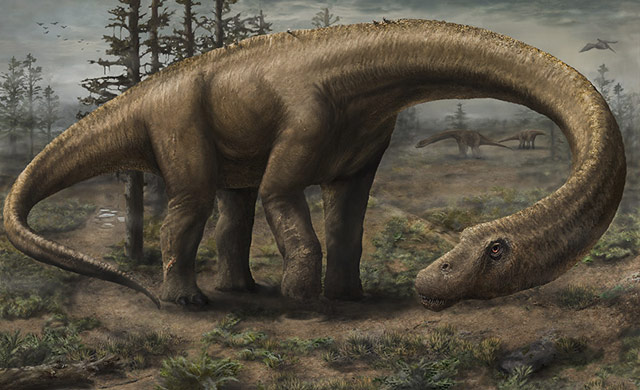
There’s a new king of the dinosaurs: Dreadnoughtus schrani. A skeleton of the species was unearthed in Argentina in 2005 and the results of the recently released analysis show this Dreadnoughtus was 85 feet long, weighed around 65 tons, and had a powerful “weaponized tail”. The kicker? It was not yet an adult and still growing when it died.
While other giants from Patagonia are known from a handful of bones, almost half of the Dreadnoughtus skeleton has been recovered. What’s more, the fossilised bones are in such good condition — even revealing where muscles attached — that the skeleton could provide unprecedented insights into the biology, movement and evolution of the group of huge plant-eating dinosaurs it belonged to, called the titanosaurian sauropods.
By comparison, an Apatosaurus (née Brontosaurus) is ~75 feet long and weighed 22 tons while a Boeing 737-900 weights around 50 tons. Here’s some more background on the Dreadnoughtus and a video showing some of the fossils:
Hmm, this is interesting. Recent studies suggest that food allergies may be caused by the absense of certain intestinal bacteria…in part due to increased use of antibiotics in very young children.
Food allergies have increased about 50% in children since 1997. There are various theories explaining why. One is that the 21st century lifestyle, which includes a diet very different from our ancestors’, lots of antibiotic use, and even a rise in cesarean section deliveries, has profoundly changed the makeup of microbes in the gut of many people in developed countries. For example, the average child in the United States has taken three courses of antibiotics by the time he or she is 2 years old, says Martin Blaser, an infectious disease specialist and microbiologist at New York University in New York City. (See here for more on the reach of microbiome research these days.)
Cathryn Nagler, an immunologist at the University of Chicago in Illinois, has spent years probing links between the immune system, intestinal bacteria, and the onset of allergies. Back in 2004, she and her colleagues reported that wiping out gut bacteria in mice led to food allergies. Since then, Nagler has continued trying to understand which bacteria offer allergy protection and how they accomplish that.

Spanning from comets in the south to the termination shock zone in the northern part of the country, The Sweden Solar System is a scale model of the solar system that spans the entire country of Sweden, the largest such model in the world.
The Sun is represented by the Ericsson Globe in Stockholm, the largest hemispherical building in the world. The inner planets can also be found in Stockholm but the outer planets are situated northward in other cities along the Baltic Sea.
Today’s brain-melter: Every Insanely Mystifying Paradox in Physics. It’s all there, from the Greisen-Zatsepin-Kuzmin limit to quantum immortality to, of course, the tachyonic antitelephone.
A tachyonic antitelephone is a hypothetical device in theoretical physics that could be used to send signals into one’s own past. Albert Einstein in 1907 presented a thought experiment of how faster-than-light signals can lead to a paradox of causality, which was described by Einstein and Arnold Sommerfeld in 1910 as a means “to telegraph into the past”.
If you emerge with your brain intact, at the very least, you’ll have lost a couple of hours to the list.
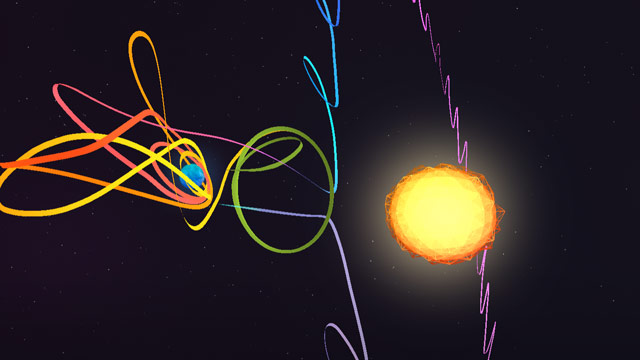
Oh man, this is great. A Spacecraft For All is an interactive video about the ISEE-3 Reboot Project, in which a group of scientists working out of an old McDonald’s crowdfunded an effort to communicate with a nearly forgotten satellite launched by NASA in 1978 to observe the Sun and chase a comet. After the intro, click on “See the Journey”…it’s well worth your time if you’re at all interested in space or science.
For instance, did you know there exists several points between the Earth and the Sun at which a satellite can orbit around, enabling spacecraft to stay more or less in the same spot for observation purposes? So cool!
The latest word on Homo floresiensis, the potential new species of hobbit-like humans discovered ten years ago in Indonesia, concerns a pair of papers which argue the single specimen found is actually a regular human with Down syndrome.
Now, the debate has reignited with two new papers published this week by a team of researchers from Penn State and other institutions. In one of those papers, they argue that the Flores skull is not a new species, but instead represents an ancient person with Down syndrome.
The researchers also point out, in the second paper, that the original report on the bones seemed to have exaggerated the skull’s diminutive size. Cranial measurements and features, along with shorter thigh bones, the team found, all correspond with modern manifestations of Down syndrome. “The difference is significant, and the revised figure falls in the range predicted for a modern human with Down syndrome from the same geographic region,” they say in a statement.
(via @daveg)
Newer posts
Older posts



















Stay Connected